1. HashMap 的基本结构
1.1 数据结构组成
HashMap 内部主要依赖以下几部分来存储数据:
数组:作为容器存储所有桶,每个桶的元素是链表或红黑树的头结点。
链表:当多个键映射到同一个桶时,这些键值对会以链表的形式串联在一起。
红黑树:当链表长度超过一定阈值时,链表转换为红黑树,以降低极端情况下的查找复杂度。
大白话:
想象一个文件柜(数组),每个抽屉(桶)里可能放着一串文件(链表),而当文件太多时,会用目录索引(红黑树)快速查找。
1.2 核心成员变量
展示代码图片
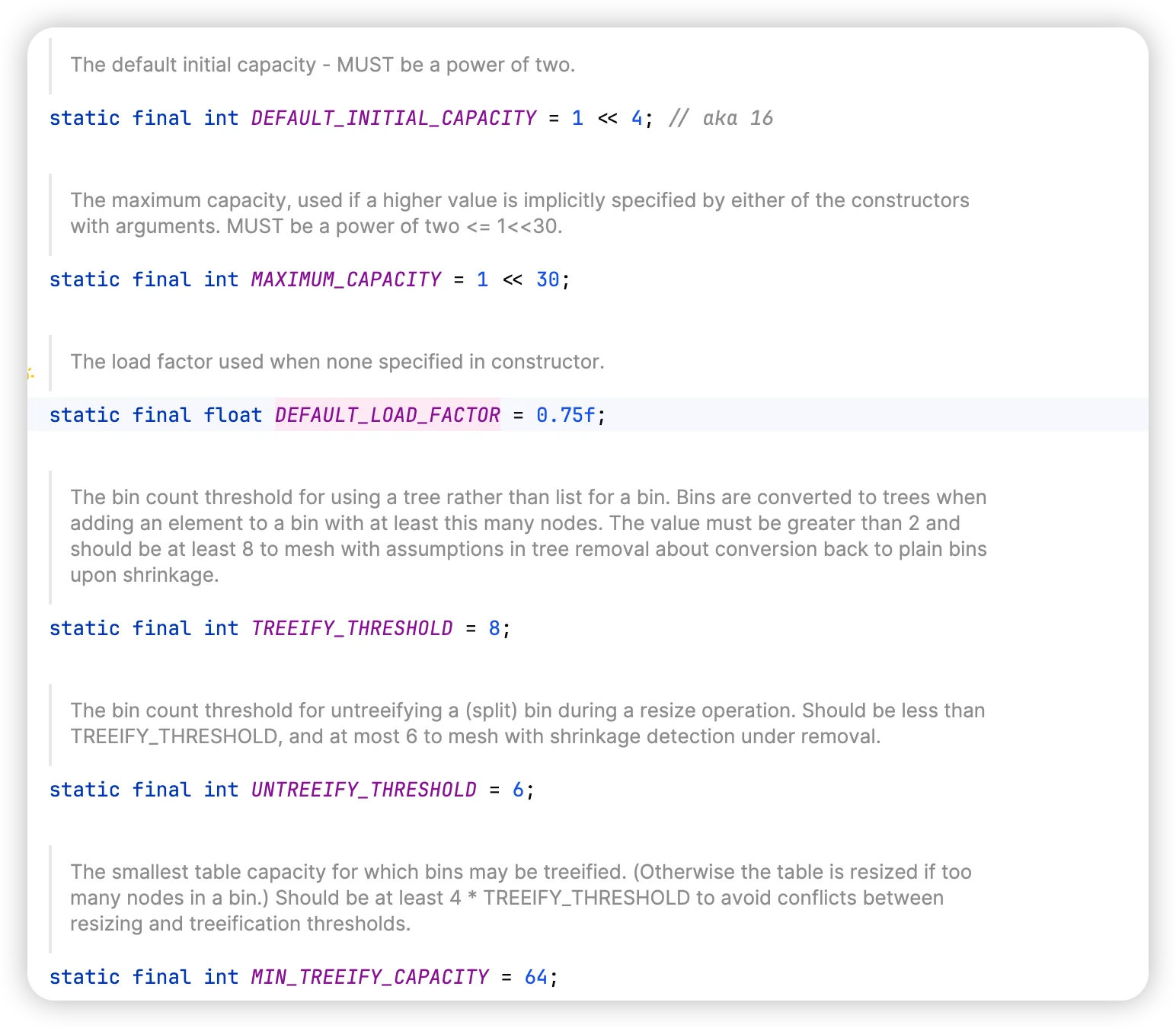
代码解释:
// 初始容量,默认 16
static final int DEFAULT_INITIAL_CAPACITY = 1 << 4;
// 默认负载因子,控制扩容阈值
static final float DEFAULT_LOAD_FACTOR = 0.75f;
// 链表长度达到8时转换为红黑树
static final int TREEIFY_THRESHOLD = 8;
// 红黑树节点数小于6时退化为链表
static final int UNTREEIFY_THRESHOLD = 6;
// 存储键值对的数组
transient Node<K,V>[] table;
// 当前存储的键值对数量
transient int size;最佳实践:
当预估数据量较大时,构造时指定合适的初始容量,能有效减少扩容次数,从而提升性能:
Map<String, Integer> map = new HashMap<>(100);1.3 示例图
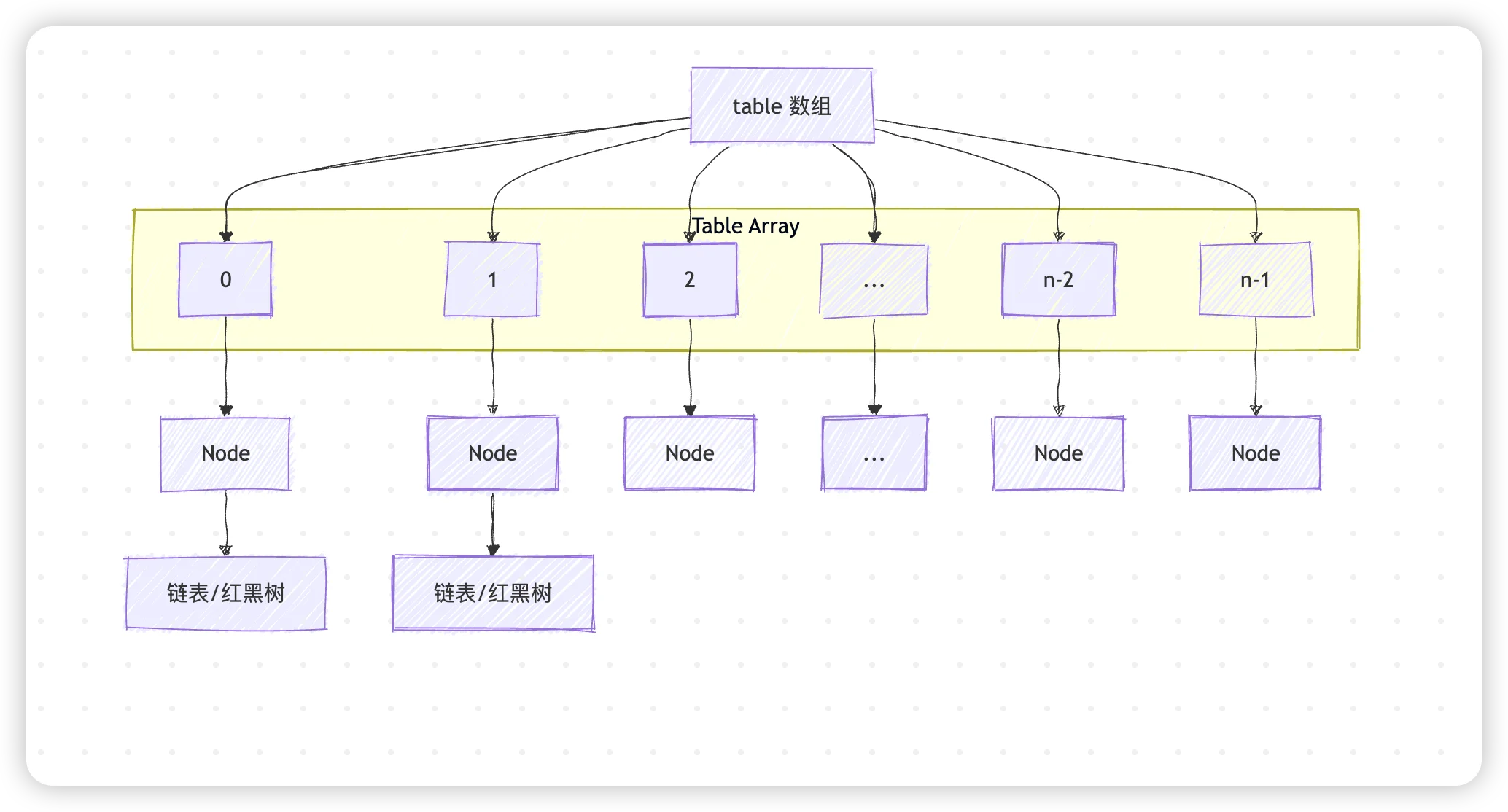
table数组
表示整个 HashMap 的“table”,即存储桶数组。
数组部分
内部由多个小盒子组成,每个盒子代表数组的一个元素(即一个桶)。
标号
0、1、2、...、n-2、n-1分别表示桶的下标。
桶中的节点
每个数组元素内可能存储一个
Node对象。如果该桶只有一个节点,则直接显示
Node;如果有多个节点,则后续节点通过指针链接形成链表。当链表长度较长时,可能转化为红黑树,这里用
链表/红黑树来表示可能的情况。
箭头
表示从数组的桶指向链表或红黑树的入口(
即链表的第一个节点或者红黑树的根节点)。
链表和红黑树的展示
链表/红黑树:说明在桶内可能是一个链表结构,也可能在达到一定阈值后被转换为红黑树结构,以提高查找性能。
2. 核心操作详解
2.1 put() 方法 —— 插入与更新
2.1.1 散列算法
为了使 key 均匀分布,HashMap 对 key 的 hashCode() 结果做了额外的混合处理:Java
/* ---------------- Static utilities -------------- */Java
/**
* Computes key.hashCode() and spreads (XORs) higher bits of hash
* to lower. Because the table uses power-of-two masking, sets of
* hashes that vary only in bits above the current mask will
* always collide. (Among known examples are sets of Float keys
* holding consecutive whole numbers in small tables.) So we
* apply a transform that spreads the impact of higher bits
* downward. There is a tradeoff between speed, utility, and
* quality of bit-spreading. Because many common sets of hashes
* are already reasonably distributed (so don't benefit from
* spreading), and because we use trees to handle large sets of
* collisions in bins, we just XOR some shifted bits in the
* cheapest possible way to reduce systematic lossage, as well as
* to incorporate impact of the highest bits that would otherwise
* never be used in index calculations because of table bounds.
*/
static final int hash(Object key) {
int h;
// 将 key 的 hashCode 进行高位和低位的混合
return (key == null) ? 0 : (h = key.hashCode()) ^ (h >>> 16);
}空键处理:若
key为 null,直接返回 0。哈希值获取:调用
hashCode()方法获取 key 的原始哈希值。右移混合:通过无符号右移 16 位,将高位信息提取出来。
XOR 操作:利用 XOR 将原始哈希值与右移后的值混合,使得最终的哈希值在低位上也包含了高位的信息,从而减小冲突概率。
2.1.2 插入流程详解
/**
* Implements Map.put and related methods.
*
* @param hash hash for key
* @param key the key
* @param value the value to put
* @param onlyIfAbsent if true, don't change existing value
* @param evict if false, the table is in creation mode.
* @return previous value, or null if none
*/
final V putVal(int hash, K key, V value, boolean onlyIfAbsent,
boolean evict) {
Node<K,V>[] tab; Node<K,V> p; int n, i;
if ((tab = table) == null || (n = tab.length) == 0) // 1. 若 table 未初始化,则进行初始化扩容
n = (tab = resize()).length;
if ((p = tab[i = (n - 1) & hash]) == null) // 2. 计算桶索引: index = (n - 1) & hash
tab[i] = newNode(hash, key, value, null);
else {
Node<K,V> e; K k;
if (p.hash == hash &&
((k = p.key) == key || (key != null && key.equals(k)))) // 3. 判断桶的首节点是否与 key 匹配
e = p;
else if (p instanceof TreeNode) // 4. 如果当前桶为红黑树,使用树插入方法
e = ((TreeNode<K,V>)p).putTreeVal(this, tab, hash, key, value);
else { // 5. 否则沿链表查找
for (int binCount = 0; ; ++binCount) {
if ((e = p.next) == null) {
p.next = newNode(hash, key, value, null);
// 链表长度达到 TREEIFY_THRESHOLD 转换为红黑树
if (binCount >= TREEIFY_THRESHOLD - 1) // -1 for 1st
treeifyBin(tab, hash);
break;
}
if (e.hash == hash &&
((k = e.key) == key || (key != null && key.equals(k))))
break;
p = e;
}
}
if (e != null) { // existing mapping for key 6. 更新存在的节点的值
V oldValue = e.value;
if (!onlyIfAbsent || oldValue == null)
e.value = value;
afterNodeAccess(e);
return oldValue;
}
}
// 7. 插入成功后,更新结构修改次数和元素数量,并检查是否需要扩容
++modCount;
if (++size > threshold)
resize();
afterNodeInsertion(evict);
return null;
}最佳实践 :
避免频繁修改 key 对象的hashCode()或equals()实现,否则可能导致元素定位异常,引起隐蔽的 bug。
2.1.3 插入过程示意图
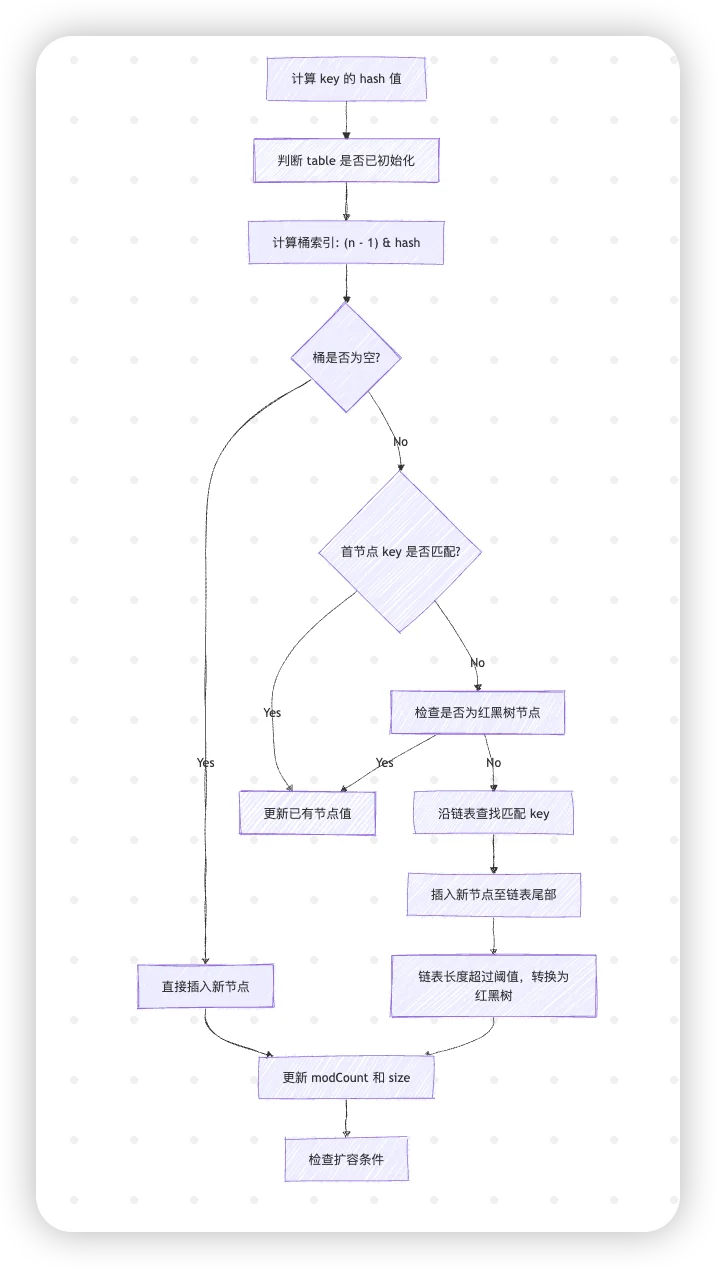
2.2 get() 方法 —— 查找过程
HashMap 的查找过程与插入类似,主要步骤为:计算 hash、确定桶索引,然后在桶内查找目标节点。
/**
* Returns the value to which the specified key is mapped,
* or {@code null} if this map contains no mapping for the key.
*
* <p>More formally, if this map contains a mapping from a key
* {@code k} to a value {@code v} such that {@code (key==null ? k==null :
* key.equals(k))}, then this method returns {@code v}; otherwise
* it returns {@code null}. (There can be at most one such mapping.)
*
* <p>A return value of {@code null} does not <i>necessarily</i>
* indicate that the map contains no mapping for the key; it's also
* possible that the map explicitly maps the key to {@code null}.
* The {@link #containsKey containsKey} operation may be used to
* distinguish these two cases.
*
* @see #put(Object, Object)Java
*/
public V get(Object key) {
Node<K,V> e;
return (e = getNode(hash(key), key)) == null ? null : e.value;
}根据 key 计算哈希值(调用 hash(key))。
调用 getNode() 方法,根据哈希值和 key 在底层数组中查找对应的节点。
如果找到节点,则返回节点的 value,否则返回 null。
PS:返回 null 不一定表示不存在映射,也可能是该 key 映射到的 value 正好为 null。可通过 containsKey() 进一步确认。
/**
* Implements Map.get and related methods.
*
* @param hash hash for key
* @param key the key
* @return the node, or null if none
*/
final Node<K,V> getNode(int hash, Object key) {
Node<K,V>[] tab; Node<K,V> first, e; int n; K k;
if ((tab = table) != null && (n = tab.length) > 0 &&
(first = tab[(n - 1) & hash]) != null) {
// 1. 检查桶中第一个节点是否匹配
if (first.hash == hash && ((k = first.key) == key || (key != null && key.equals(k))))
return first;
// 2. 如果桶中有后续节点,继续查找
if ((e = first.next) != null) {
// 如果桶内结构为红黑树,则采用树查找方式
if (first instanceof TreeNode)
return ((TreeNode<K,V>)first).getTreeNode(hash, key);
// 否则,遍历链表
do {
if (e.hash == hash &&
((k = e.key) == key || (key != null && key.equals(k))))
return e;
} while ((e = e.next) != null);
}
}
return null;
}获取 table 和桶长度:首先检查 HashMap 的底层数组
table是否已初始化,并获取其长度。确定桶索引:通过
(n - 1) & hash来计算 key 应该存放在数组中的桶位置,然后获取该位置的第一个节点(first)。
直接命中:
检查桶中第一个节点是否匹配。匹配条件为:节点的 hash 与计算的 hash 相等;
且节点的 key 与查找的 key 相同(相等判断既支持 == 也支持 equals())。
如果匹配,则直接返回这个节点。
遍历桶中的链表或红黑树:
如果第一个节点不匹配且桶中存在后续节点(first.next 不为 null):红黑树查找:如果桶中的结构是红黑树(first instanceof TreeNode),则调用红黑树的查找方法
getTreeNode()。链表遍历:否则,遍历链表中每个节点,依次比较节点的 hash 和 key,直到找到匹配的节点并返回。
如果遍历完桶中所有节点都没有找到符合条件的节点,则返回 null。
2.2.1 查找流程示意图
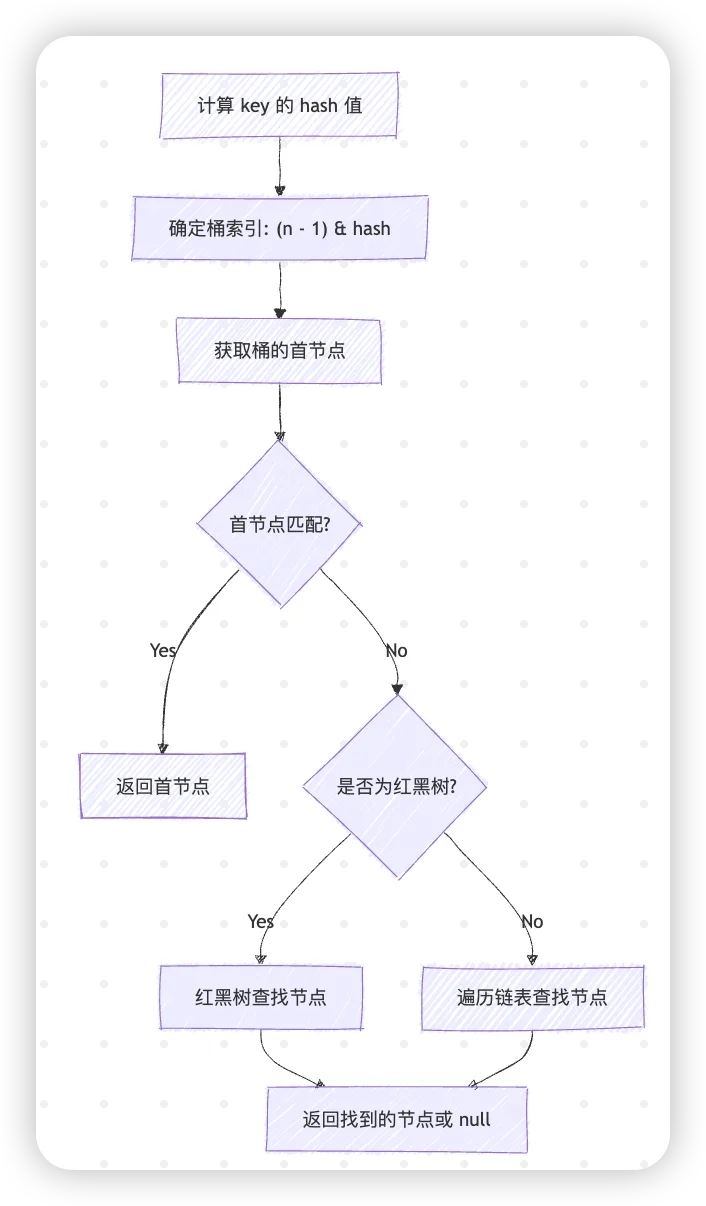
最佳实践:
尽量避免使用会产生大量哈希碰撞的 key 类型,优先选择不可变对象作为键,确保hashCode()分布均匀。
2.3 resize() 方法 —— 动态扩容
扩容是 HashMap 保证性能的关键机制。当元素数量超过阈值时,HashMap 将底层数组扩容,并重新分配元素。
/**
* Initializes or doubles table size. If null, allocates in
* accord with initial capacity target held in field threshold.
* Otherwise, because we are using power-of-two expansion, the
* elements from each bin must either stay at same index, or move
* with a power of two offset in the new table.
*
* @return the table
*/
final Node<K,V>[] resize() {
Node<K,V>[] oldTab = table;
int oldCap = (oldTab == null) ? 0 : oldTab.length;
int oldThr = threshold;
int newCap, newThr = 0;
if (oldCap > 0) {
if (oldCap >= MAXIMUM_CAPACITY) {
threshold = Integer.MAX_VALUE;
return oldTab;
}
else if ((newCap = oldCap << 1) < MAXIMUM_CAPACITY &&
oldCap >= DEFAULT_INITIAL_CAPACITY)
newThr = oldThr << 1; // double threshold
}
else if (oldThr > 0) // initial capacity was placed in threshold
newCap = oldThr;
else { // zero initial threshold signifies using defaults
newCap = DEFAULT_INITIAL_CAPACITY;
newThr = (int)(DEFAULT_LOAD_FACTOR * DEFAULT_INITIAL_CAPACITY);
}
if (newThr == 0) {
float ft = (float)newCap * loadFactor;
newThr = (newCap < MAXIMUM_CAPACITY && ft < (float)MAXIMUM_CAPACITY ?
(int)ft : Integer.MAX_VALUE);
}
threshold = newThr;
@SuppressWarnings({"rawtypes","unchecked"})
Node<K,V>[] newTab = (Node<K,V>[])new Node[newCap];
table = newTab;
if (oldTab != null) {
for (int j = 0; j < oldCap; ++j) {
Node<K,V> e;
if ((e = oldTab[j]) != null) {
oldTab[j] = null;
if (e.next == null)
newTab[e.hash & (newCap - 1)] = e;
else if (e instanceof TreeNode)
((TreeNode<K,V>)e).split(this, newTab, j, oldCap);
else { // preserve order
Node<K,V> loHead = null, loTail = null;
Node<K,V> hiHead = null, hiTail = null;
Node<K,V> next;
do {
next = e.next;
if ((e.hash & oldCap) == 0) {
if (loTail == null)
loHead = e;
else
loTail.next = e;
loTail = e;
}
else {
if (hiTail == null)
hiHead = e;
else
hiTail.next = e;
hiTail = e;
}
} while ((e = next) != null);
if (loTail != null) {
loTail.next = null;
newTab[j] = loHead;
}
if (hiTail != null) {
hiTail.next = null;
newTab[j + oldCap] = hiHead;
}
}
}
}
}
return newTab;
}resize() 方法的主要任务是:
初始化/扩容:如果当前 table 为空,则初始化;否则将数组容量翻倍。
重新计算阈值:根据新的容量和负载因子计算新的扩容阈值。
重新散列:将旧数组中每个桶中的节点重新分布到新数组中,由于容量是原来的两倍,所以每个节点只可能保持在原位置或者移动到 “原位置 + oldCap”。
2.3.1 扩容流程图
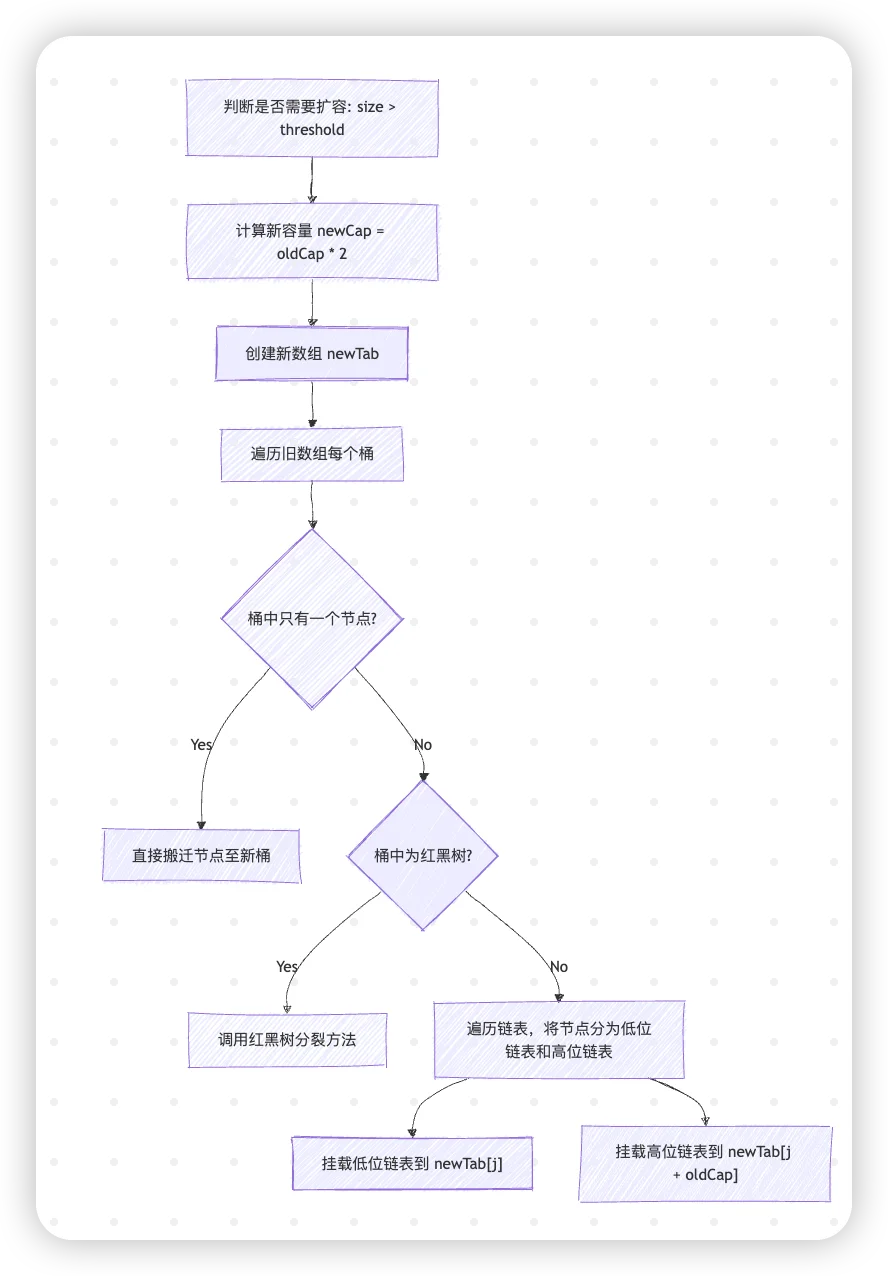
最佳实践
为避免频繁扩容,建议在构造 HashMap 时指定初始容量。如果能预估数据量较大,合理设置负载因子也可以在空间与性能之间取得平衡。
注:流程图是AI根据底层代码分析根据mermaid生成




默认评论
Halo系统提供的评论